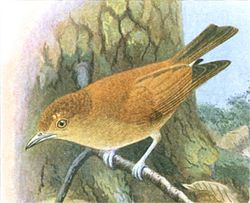| Cinnamon ibon | |
|---|---|
 | |
| Scientific classification | |
| Domain: | Eukaryota |
| Kingdom: | Animalia |
| Phylum: | Chordata |
| Class: | Aves |
| Order: | Passeriformes |
| Family: | Passeridae |
| Subfamily: | Hypocryptadiinae Hachisuka, 1930 |
| Genus: | Hypocryptadius Hartert, 1903 |
| Species: | H. cinnamomeus |
| Binomial name | |
| Hypocryptadius cinnamomeus Hartert, 1903 | |
The cinnamon ibon (Hypocryptadius cinnamomeus) is a species of bird endemic to the mountains of Mindanao in the Philippines. [1] Monotypic within the genus Hypocryptadius, it is classified as an old world sparrow. [2] Its natural habitat is tropical moist montane forests and mossy forests above 1,000 metres (3,300 ft). [1]

